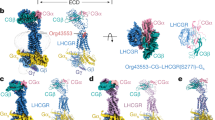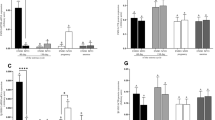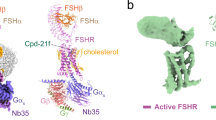Abstract
IT was shown1 that strips of immature calf uterus incubated in vitro in the presence of 10−9 M 3H-oestradiol-17β concentrate the hormone 400 per cent or more; about 80 per cent of the radioactivity in the tissue is found associated strongly but non-covalently with the nuclear fraction and consists of intact 17β-oestradiol; treatment of the nuclear fraction with 0.4 M KCl at pH 8.5, as already applied by us to rat2, solubilizes an oestradiol-macromolecule complex which sediments at about 5S; the macromolecule is protein, or at least the moiety binding the hormone is protein. A similar 5S oestrophilic component from calf uterus was obtained by Jungblut et al.3. Recent studies4–6 suggest that the 5S macromolecule originates from the 8–10S macromolecular component which binds 17β-oestradiol and is found in the high speed supernatant of uterus.
This is a preview of subscription content, access via your institution
Access options
Subscribe to this journal
Receive 51 print issues and online access
$199.00 per year
only $3.90 per issue
Buy this article
- Purchase on Springer Link
- Instant access to full article PDF
Prices may be subject to local taxes which are calculated during checkout
Similar content being viewed by others
References
Puca, G. A., Nola, E., and Bresciani, F., Atti Accad. Naz. Lincei (Rend. Sci. Fis. Mat. e Nat.), 46, 268 (1969).
Puca, G. A., and Bresciani, F., Nature, 218, 967 (1968).
Jungblut, P. W., Haetzel, I., De Sombre, E. R., and Jensen, E. V., in Eighteenth Colloquium Gesellsch. Physiol. Chemie, 58 (Springer, Berlin, 1967).
Jensen, E. V., Suzuki, T., Kawashima, T., Stumpf, W. E., Jungblut, P. W., and De Sombre, E. R., Proc. US Nat. Acad. Sci., 59, 632 (1968).
Erdos, T., Biochem. Biophys. Res. Commun., 32, 338 (1968).
Korenman, S. G., and Rao, B. R., Proc. US Nat. Acad. Sci., 61, 1028 (1968).
Bush, I. E., in Proc. Second Intern. Cong. Endocrinol., London 1964, 1324 (Excerpta Medica Foundation, Amsterdam).
Martin, R. G., and Ames, B. R., J. Biol. Chem., 236, 1372 (1961).
Edsall, J. T., and Wyman, J., in Biophysical Chemistry, 594 (Academic Press, New York, 1958).
Duncan, G. W., Lyster, S. C., Clark, J. J., and Lednicer, D., Proc. Soc. Exp. Biol., 112, 439 (1963).
Sandberg, A. A., and Slaunwhite, W. R., J. Clin. Invest., 36, 1266 (1957).
Scatchard, G., Ann. NY Acad. Sci., 51, 660 (1949).
Huggins, C., and Jensen, E. V., J. Exp. Med., 102, 335 (1955).
Monod, J., and Jacob, S., Cold Spring Harbor Symp. Quant. Biol., 26, 389 (1961).
Author information
Authors and Affiliations
Rights and permissions
About this article
Cite this article
PUCA, G., BRESCIANI, F. Association Constant and Specificity of Oestradiol-receptor Interaction. Nature 223, 745–747 (1969). https://doi.org/10.1038/223745a0
Received:
Revised:
Issue Date:
DOI: https://doi.org/10.1038/223745a0
This article is cited by
-
Purification of Oestradiol Receptors by Affinity Chromatography
Nature New Biology (1973)
-
Further investigations on the behaviour of cultivated salivary gland adenocarcinoma of the mouse
Zeitschrift f�r Krebsforschung und Klinische Onkologie (1973)
-
Binding Activity of Oestrogen Receptors destroyed by Iodination
Nature (1970)
-
Association of 3H Corticosterone-1,2 with Macromolecules extracted from Brain Cell Nuclei
Nature (1970)
Comments
By submitting a comment you agree to abide by our Terms and Community Guidelines. If you find something abusive or that does not comply with our terms or guidelines please flag it as inappropriate.



